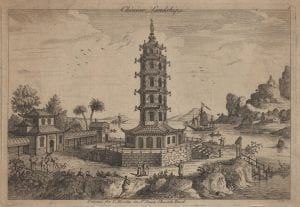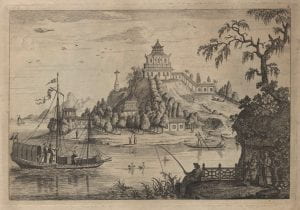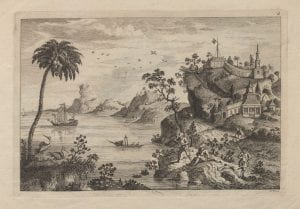Chinoiserie: designs of the East and West


Occasionally, works of art in the Baillieu Library Print Collection will remain mysteries even after a bit of research, such as this series of five Chinese landscapes. I can say with some certainty that the artist was German/English painter Augustin Heckel, and the engraver was Englishman John June, and they were probably created around 1750-60. While the publisher, Thomas Bowles of London, published a number of compendiums of Chinese prints, what editions these landscapes were published in and where and what exactly they depict remains uncertain.
Yet these prints complex history is an essential part of their identity. They are not quite English prints because of the Chinese topography, figures, and buildings they represent, but neither are they Chinese, as they were created by and for a Western audience. They are hybrids, symbolic of cross-cultural encounters between China (but more accurately Asia) and Europe in the 18th century. [1.]
Chinoiserie is the French name given to the 18th century European interest in Chinese art, commodities and style—such porcelain, silk, lacquerware, folding screens, and so on [2.] — that was replicated by European craftsmen. Chinoiserie is a term still used to describe Chinese-inspired design and art today, such as wallpaper or crockery. For 18th century consumers, Chinese arts were not only visually fascinating because they differed from mainstream European visual style, but they were symbolic of a highly exoticised culture and carried all the intrigue and mystique of these far-off locations.
In 1753 Thomas Bowles published a perfect example of 18th century chinoiserie: The Emperor of China’s Palace at Pekin, and His Principal Gardens, as well in Tartary, as at Pekin, Gehol and the Adjacent Countries; with the Temples, Pleasure-Houses, Artificial Mountains, Rocks, Lakes etc. as Disposed in Different Parts of Those Royal Gardens. The sweeping title was a bound series of 20 prints originally by Italian artist Matteo Rippa (1682-1746). Rippa worked as missionary priest for the Kangxi Emperor at his summer palace at Chengde between 1711 and 1723, and depicted the landscapes he saw there. [3.]
While staying at the palace and creating the series of prints of the palace grounds, Rippa kept a journal. In it he wrote:
In Ge-hol [Chengde] one day I had the pleasure of climbing a mountain which dominated the others because of its height, from which one could see all around what appeared to be a sea of agitated mountains, whose peaks looked like so many rolling waves. This panorama was truly most curious, and unique in the whole World. [4.]
He describes beautiful gardens decorated with pagodas, pavilions and little cascading rivers—manicured nature in miniature. His writing could easily be describing his prints in The Emperor of China’s Palace at Pekin or any one of the five Chinese landscapes in the Baillieu collection. And indeed, Rippa’s idealised descriptions of Chengde and the prints serve a similar function. This is a romanticised version of China that many Europeans would only encounter filtered through the lens of an artist like Rippa, and in publications like Bowles’ The Emperor of China’s Palace at Pekin.
Perhaps even more relevant to the prints in the Baillieu, is that in 1760 Bowles published The Rice Manufactury in China (sic). [5.] This book featured prints by Augustin Heckel, engraved by John June. All prints are copies of originals of the 1145 Gengzhi Tushi (Poems of farming and weaving) by the Chinese printer Lou Shou. [6.] For example: Heckel’s Agriculture: raking rice paddies in China with an ox-drawn plough is a copy in reverse of the Gengzhi Tushi originals.

The third print in the Baillieu’s series depicts a scene with a river, mountains and a small building in which a woman hands a young baby to another, seated figure. There is a toddler at her leg, and a third figure in the background holding a tray. While the river and mountains have no obvious, discernible origin, the scene with the baby by no means original to Augustin Heckel or Thomas Bowles’ printing. It too can be found, in reverse, in the Gengzhi Tushi.
Therefore, while I cannot say for certain what this series of five prints was intended for, or exactly which Chinese originals they were based off, they were, at least in part, inspired by the Gengzhi Tushi, and likely other original Chinese landscape prints that I have been unable to uncover. It is obvious that Bowles and his artists were in the business of replicating Chinese prints for an English audience and the fact they were not direct copies, or amalgamations of several designs or places was, to the artists and publisher, largely beside the point. To their audience, the difference was negligible.
These prints were not intended to be faithful to the true reality of China, its people, art and landscapes. This kind of 18th century Orientalism sought to capture an unprecise sense of wonder and otherness rather than be faithful to the source, and they are chinoiserie instead of simply Chinese because embellishment and replication is part of their nature. Like Rippa’s descriptions and prints of the gardens at Chengde, they inspired wonder to the European audiences who never had, and likely never would, encounter these places in the flesh.


Bianca Arthur-Hull
Special Collections Blogger
Notes and further reading
[1.] Porter, David L. ‘Monstrous Beauty: Eighteenth-Century Fashion and the Aesthetics of the Chinese Taste,’ Eighteenth-Century Studies, vol. 35, no. 3, 2002, pp. 395–411.
[2.] Rinaldi, Bianca Maria, editor. ‘Matteo Ripa (1682–1746)’ Ideas of Chinese Gardens: Western Accounts, 1300-1860, University of Pennsylvania Press, Philadelphia, 2016, pp. 83–90.
[3.] The Place for Thinking, The British Library, accessed October 20 2020.
[4.] As cited in Rinaldi, Bianca Maria, editor. ‘Matteo Ripa (1682–1746)’ Ideas of Chinese Gardens: Western Accounts, 1300-1860, University of Pennsylvania Press, Philadelphia, 2016, pp. 83–90.
[5.] Reed, Marcia and Demattè, Paola, editors. China on Paper: European and Chinese Works from the Late Sixteenth to the Early Nineteenth Century. Getty Publications, 2011.
[6.] Reed, Marcia and Demattè, Paola, editors. China on Paper: European and Chinese Works from the Late Sixteenth to the Early Nineteenth Century. Getty Publications, 2011.
Categories
Leave a Reply